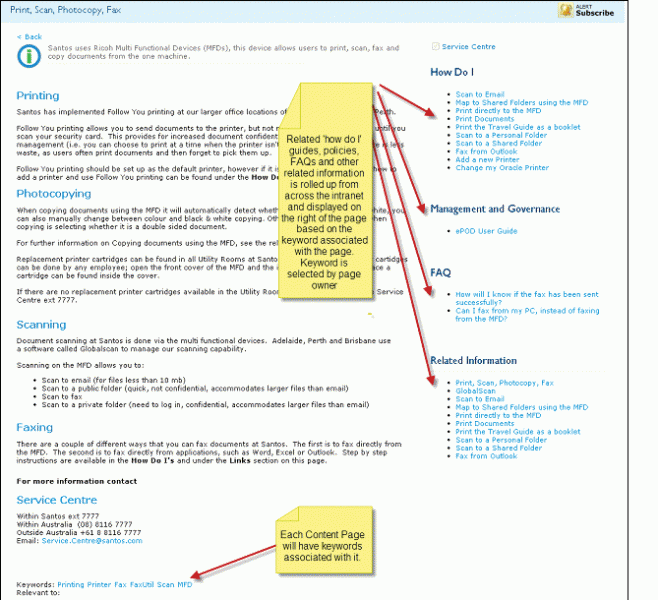Santos drills deep into SharePoint 2010 for information management

Multinational Australian energy giant Santos is revolutionising its information management practices with a company-wide deployment of SharePoint 2010.
Santos – one of Australia’s top publicly listed companies and a leading gas producer – has 2400 employees working across its operations in Australia, Indonesia, Papua New Guinea, Vietnam, Bangladesh, India and Central Asia. The company has developed one of Australia’s largest onshore resources projects in the Cooper Basin, and is embarking on a suite of growth development and exploration projects that include the US$16 billion GLNG project in Queensland.
Santos’ journey with SharePoint began with SharePoint Portal Server 2001 over a decade ago. Santos then fully embraced SharePoint by building its entire intranet on SharePoint 2003 – which currently holds over 700,000 documents.
A major move is now underway to offer widespread deployment of SharePoint 2010 for the Santos intranet and broader collaboration as part of a program known internally as Information Management @ Santos (IM@S).
 Kartic Kapur, Team Leader SharePoint Application Support in Santos’ Information Systems team, said “there was a huge fileshare culture, and many people were using email to manage information.”
Kartic Kapur, Team Leader SharePoint Application Support in Santos’ Information Systems team, said “there was a huge fileshare culture, and many people were using email to manage information.”
“There was four decades of information held in file shares. From a users’ perspective, the sheer amount of uncontrolled documents caused ‘needle in the haystack’ syndrome, where they could not find the information they required.”
In addition to the use of SharePoint 2003, OpenText Livelink was deployed at Santos’ Gladstone- based operations in Queensland.
In 2009, the Santos IM team received approval to produce a business case for the IM@S project.
“We did surveys and found the major frustration was that people couldn’t find anything,” said Kapur.
“Our studies showed that the time taken by the average staff member to find information or recreating information that already exists took up an astounding 21 hours per week.
“We have a very diverse user base. There is a difference in the way a geophysicist and engineer, finance, lawyer thinks about information management.
“With our SharePoint 2010 rollout we are starting at the bottom instead of putting the technology in and hoping it will solve problems.”
Santos has two approaches it descibes as as above the line and below the line. The intranet is for above the line content, that is, everything that is likely to be required by any employee to perform their job is located here. More fine-grained information sharing is delivered via individual SharePoint Team Sites established for below the line content “collaboration.”
Sava Politis, Business Analyst with the IM@S project, said: “We have undertaken the inevitable task of cleansing this information and implementing an information framework and cutting-edge intranet design which has pioneered a new level of SharePoint collaboration.”
“We had piles of information everywhere, team sites, intranets. We needed to pull it out and make it consistent across the whole company.”
Migrating content from SharePoint 2003 to the new 2010 intranet was a big job. After the analysts delivered the essential keywords to use for the business unit being migrated, a small team of IT graduates hired for the task would manually import content and add the keywords.
“It was a lot of work,” said Politis. “We had a tight project schedule so we didn’t get the keywords as cleanly filtered as we would have liked, and had to go through and clean them after the intranet went live. If you have 5000 keywords running from A-Z and only 1000 are necessary, it leaves your users with a lot of unnecessary scrolling.”
Nine individual FAST servers have been implemented to provide enterprise search.
“Everything that was wrong with SharePoint 2003 has become our objective with 2010,” said Politis.
“Search was very poor which is why we have put in all the FAST servers. We are also employing an information management framework so all information is tagged. All policies are tagged as policy documents, the same with guidelines, work instructions.
“That’s been done at intranet level but we are also doing it below the line at the team site level as well so we have a full classification of all documents at Santos.”
Scinaptic OnePlaceMail has been acquired to integrate access to SharePoint content within the Outlook 2010 email client, and provide the ability to drag and drop emails into SharePoint.
AvePoint’s DocAve platform is being utilised for backend management of SharePoint and the migration of content. SharePoint is used for the company intranet and to provide team sites for individual projects.
“We do recognise that there are tools that will not be replaced, for instance engineering data management tools or specific solutions for measuring seismic data,” said Kapur.
“SharePoint is very widely adopted, and we are now migrating information to 2010 using Content Types. Previously there was a different team site for every well, a document library for every different component. Now with content types we can manage them better.”

Roiling out SharePoint 2010 “below the line” involves a measured approach that begins with a small team comprising a SharePoint specialist, business analyst and coordinator learning about the business processes of the team that is migrating. This process will continue for at least the next two years across 16 different business divisions at Santos before the migration is complete.
Santos is also looking to automate more business processes with Nintex Workflow 2010, which adds a drag-and-drop workflow designer to SharePoint 2010. It previously had a limited number of approval workflows created using InfoPath forms in SharePoint 2003. However before launching into this project the IM@S team is keen to address the issue of governance.
“Workflow can easily create processes that are very siloed and all of a sudden you have them multiplying everywhere, so at this stage we are writing governance for business process management,” said Kapur.
A new employee induction system is being built with Nintex Workflow 2010 to set tasks for new staff in their first six months of employment and generate email reminders and event triggers to keep track of their progress. Another major project on the IM@S roadmap is to create a records centre using i5 Records Management Software. This will be used to centrally control records in SharePoint, automate the classification of records and support the application and management of information policies.
Users have the option of moving email to SharePoint and storage in the records centre, with Enterprise Vault sitting behind Exchange 2010 for permanent archiving of all mail.
